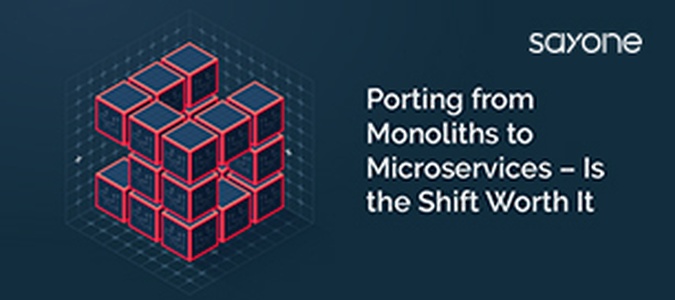Future Scope of Microservices – What is in Store

Share This Article
Porting from Monoliths to Microservices
Table of Contents
Subscribe to Our Blog
We're committed to your privacy. SayOne uses the information you provide to us to contact you about our relevant content, products, and services. check out our privacy policy.
We are living in a time when software production has been primed to perform. Coupled with intelligence and efficiency, the future of software development is still bright and is predicted to grow in the coming years. What matters not is the number of lines, but the rate at which software upgrades and updates find their way to you.
Therefore, the future of software development is all about the speed of continuous integration. The two main architecture systems that are being used in building software are the monolithic and microservices architectures.
Challenges of Monolithic Architecture Systems
Most organizations start with monolithic systems but generally start facing challenges when the business grows bigger. Some are listed below:
- As the application grows bigger, it becomes difficult to understand.
- Developers who start the programs and those who maintain them become different groups with the passage of time. Therefore, difficulty in understanding the application becomes more.
- Reuse of code is very limited only through shared libraries. This makes the coupling very tight.
However, microservices have the following advantages:
- Adding new people to the microservices team is a much easier job. Ne services can be handed over to new teams.
- Unused modules can be cleaned easily.
- The maintenance is also very easy with minimum downtime. The other microservices can continue to run undisturbed.
Read our blog "A Look at the Uber Microservices Architecture".
Adopting Microservices
Microservices development is started when a large application is split into smaller independent modules. Each of these services is designed to perform a single business well. This model increases both the application’s scalability and agility. The code can be reused when implementing a new service (loose coupling).
Types of Microservices
The different microservices are the differential and integral types.
Differential
In this type of architecture, the architecture decomposes into self-contained services which can break into transactions. This translates to one transaction being distributed to multiple services.
Download Ebook for FREE "How to choose the best microservices vendor and trim the cost"
Integral
Microservices applications are built to weave many small microservices into specific user experiences. These applications address many diverse requirements, such as service level management, on-demand provisioning, and dynamic composition.
Advantages of Microservices
Microservices present many unique advantages:
- Autonomous: Each of the microservices can be developed up to any level of performance independently. It can also be scaled without affecting the functionality of another service in any way.
- Specialization: Each of the microservices can be specialized to perform only one function and do it very well. When a microservice is sufficiently scaled up, it can be split further into smaller microservices. This helps the system to function reliably.
- Resilience: The microservices are fully independent. That is, any service that fails does not affect another service. This vastly improves the system's resilience.
- Team Freedom: Different teams handle the microservices independently. Therefore, they have the freedom to choose the technology that suits the application best. They also address both the goals and challenges of the microservices independently.
- Easily Deployable: Continuous integration and agile development methods can be easily applied to microservices, with the result that new updates can be easily rolled out. Mistakes can also be easily rolled back. Time-to-market can be accelerated considerably.
Disadvantages of Microservices
Complexity: Microservices have increased connections and, therefore, the complexity also increases. Management is more challenging.
Resources: More resources have to be kept ready for transitioning into and running microservices.
Consistency: Data consistency is challenging because of the independent services. Each service maintains its own database.
Security: Security is a concern with multiple services communicating with one another at a time.
Planning to shift to microservices? Call us at SayOne or drop us a note!
How Some Organizations have Implemented Microservices in Innovative Ways
Most startups in the world that are now successful business leaders began with monolithic software applications. However, as their businesses grew, complexities increased and they had to shift to the microservices architecture system. They used new methods to handle the complexities of their business systems. Some examples of how companies coped with their complexities and how they adopted microservices are briefly detailed below.
1: Amazon

Amazon faced extensive server demands and the existing monolithic architecture was unable to meet them. New developers could not understand the package in full and became more distanced from the final goal of expanding the system to meet new demands. This situation that was prevalent on Amazon.com in 2001 inspired the decoupling of the services, which later ended up as a microservices architecture system.
In 2000, Amazon was struggling to coordinate process changes (that happened quickly because of expanding business) from hundreds of developers. These changes were queued up and waited to be moved into production. The ultimate result was that the SDLC became both bulky and long.
Download and read the eBook "Porting from Monoliths to Microservices".
This forced Amazon to create smaller teams, each having a goal of solving the problem as well as embedding a specific service in a container which could be independently deployed. Simultaneously, Amazon continuously built new features into the existing system.
The result was a microservices system that ended up as highly scalable and enabled Amazon to reach new services to the market in a much shorter time.
2: Uber

Uber started as a taxi-ailing app in San Francisco city. Here, a single monolithic codebase managed most of the requirements, such as business processes, billing, payments, and connecting with the driver. However, things became complicated when the business grew. Uber now covers more cities and is providing more services.
When new features were added, the package became very tightly coupled. All the logic is held in one place became problematic. Bringing about even a small change required that the full application be reworked upon and redeployed. Continuous integration soon became a big liability.
Read our blog : How to find the best microservices development company
Intertwined dependencies on the monolith decimated the ownership model. Migration became difficult. New developers could not contribute anything to the monolith. Small mistakes created catastrophes. Uber decided to shift to cloud-based services. Uber built microservices for different functions like billing and management of trips and passengers. The services are communicated via API gateways.
Uber also developed global standards for their microservices. They set up quantifiable standards for documentation, reliability, fault tolerance, stability, etc. They measured these parameters based on business metrics like webpage views. Soon, their services were of the highest quality.
3: Spotify

Spotify, the music company, serves more than 170 million users worldwide. In order to be the world’s best music service, the organization wanted to make a few changes.
The organization also wanted to free up developers from just provisioning resources and maintaining them. Spotify also wanted to derive advantages from Google Cloud’s latest innovations.
Spotify designed a migration plan in 2015 and they split this activity into two parts: services and data. A team of engineers and Google experts first created a live visualization of the migration process to easily track progress.
Read our blog : What Kind of Challenges Can Microservices Help You Overcome
The team then mapped dependencies so that each of the microservices relies on 10 to 15 other microservices. The engineers then moved the systems in just a 2-week window, and during this period, they temporarily put on hold all the product development activity.
The next task involved moving the data. Using the dependency map, the task was to move about 20 000 data jobs to the Google Cloud without any downstream disruptions. The data transfer job lasted for almost a year.
4: Etsy

Poor server processing time which cropped up regularly prompted Etsy to think of microservices. There were performance issues too. Concurrent transactions seemed to be the only way to improve processing time.
Etsy’s earlier system was based on sequential processing and was very sluggish. Inspired by Netflix’s shift to microservices architecture, Etsy first created a two-tier API with meta endpoints to transform low-level general-purpose resources on the server-side into device-specific resources.
Read our blog : Why Business leaders should care about Microservices
Even after the initial steps were taken, a lack of concurrency continued to limit the eCommerce processing speed. They could not achieve the performance goals until they used cURL for parallel HTTP calls to achieve API concurrency. They made a few more associated changes and launched Etsy’s new structure in 2016.
Now their microservices structure works to produce faster upgrades, can be easily scaled, allows concurrent processing, and supports innovation as and when it is required.
5: Netflix

In 2008, Netflix wanted to change it’s codebase and faced a major outage due to database corruption. Netflix was then a DVD rental firm. They could not ship DVDs when the subscribers requested them.
Netflix then shifted to a distributed data system on a cloud server. They chose AWS to provide horizontally scalable systems and other services/features.
Read our blog : Should you migrate from monolith to microservices architecture
Netflix started their migration in 2009 and completed the final process after nearly 3 years. ThenNetflix transformed all their user-facing programs into independent microservices. The transformation was fully completed in 2012.
All service outages on Netflix disappeared by 2015, and Netflix was able to handle about 2 billion API requests every day. Today, Netflix has over 139 million customers across 190 nations. Today, Netflix’s has over 700 microservices systems that function independently.
Future Scope of Microservices
Many organizations have already adopted this architecture and many more are ready to follow suit. A majority of software developers expect that microservices will become the default software architecture system in the time to come. There are, however, a few more predictions about architectural styles that are doing the rounds:
Multiple Microservices
In this model, applications would be built by linking the different APIs and services together.
Read our blog : The 5 Best Microservices Technologies List
Serverless Architecture
The establishment of serverless architectures will strengthen on-demand compute resources. Newer tools for quickly building and deploying microservices will emerge, eliminating the need for large upfront investment.
Function as a Service
A decentralized application stack and intelligence-driven microservices with in-memory computers performing real-time analytics will be the trend.
Multi-Cloud Environment
Another exciting development foreseen is the use of microservices across different cloud storage environments, which brings added advantages of their specific features. Microservices that are related to information management and databases can utilize Oracle’s cloud for optimization. Other microservices can benefit from Amazon S3 for storage and archiving functions, while integrating AI-based features and analytics from Azure.
Why Choose SayOne Technologies
At SayOne Technologies, we design your complete migration into a microservices model. We can also make the application an easy-to-maintain and scalable solution.
The key discriminators that make us the best in the market are in microservices solutions that are:
- Domain-driven design to preempt failure
- Have a high level of scalability
- Work on a decentralized database design
- Help in easy failure isolation, and
- Enable continuous delivery via the DevOps culture
Closing Thoughts
There are going to be many more organizations hopping onto the microservices bandwagon. Some of them are going to combine microservices with other disruptive technologies to become leaders in their niche.
Most businesses are looking at improving cost efficiencies, and in this context, serverless architecture is going to gain more popularity in the coming years. The future scope of microservices looks bright indeed.
Can microservices help your business move forward? Call us at SayOne today!
Share This Article
FAQs
Microservices will help organizations in the future by allowing them to quickly and easily build, test, and deploy applications. They will also enable organizations to easily scale their applications to meet changing demands, reduce costs, and increase agility. Additionally, microservices will provide organizations with more control over their applications, allowing them to better manage their resources and develop more efficient and tailored solutions.
Some of the challenges associated with the use of microservices include the complexity of managing multiple services, the need for orchestration, and the need for a reliable infrastructure. Additionally, microservices may require more upfront investment to set up, and there may be a need for skilled personnel to manage and maintain them.
The scope of microservices in Java is vast. Java is a very popular language for developing applications, and microservices are a great way to build applications that are more scalable, resilient, and easier to maintain. Java is the language of choice for many microservice architectures, since it has great support for distributed systems, and it is platform independent. Java microservices can be used to build web applications, mobile apps, Internet of Things (IoT) systems, and cloud-native applications. Additionally, microservices can be used to build distributed databases, stream processing systems, and batch processing systems.
Subscribe to Our Blog
We're committed to your privacy. SayOne uses the information you provide to us to contact you about our relevant content, products, and services. check out our privacy policy.



